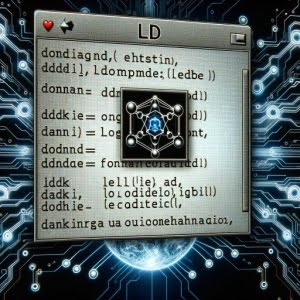ld Linux Command | Your Linkage Editor Guide

Ever found yourself puzzled over the ‘ld’ command in Linux? You’re not alone. Many developers grapple with this tool, but it’s a crucial part of the Linux ecosystem. Think of the ‘ld’ command as a master builder – it takes various object files and constructs an executable. It’s a powerful tool that forms the backbone of many Linux operations.
In this guide, we’ll walk you through the ld command in Linux, from its basic usage to advanced techniques. We’ll explore ld’s core functionality, delve into its advanced features, and even discuss common issues and their solutions.
So, let’s dive in and start mastering the ld command in Linux!
TL;DR: What is the ld Command in Linux?
The
ldcommand in Linux is a link editor, also known as a linker. It is used with the syntax,ld [options] inputfile outputfileIt combines object and archive files to create an executable
Here’s a simple example:
ld -o output_file input_file.o
In this example, ld is the command, -o is an option that specifies the name of the output file, output_file is the name of the executable file we want to create, and input_file.o is the object file that ld uses to create the executable.
This is just a basic usage of the ld command in Linux. There’s much more to it, including advanced techniques and troubleshooting common issues. Continue reading for a comprehensive guide on mastering the ld command in Linux.
Table of Contents
- Understanding the Basics of the ld Command in Linux
- Advanced Usage of the ld Command in Linux
- Exploring Alternative Methods for Creating Executables
- Troubleshooting Common Issues with the ld Command
- Unveiling the Fundamentals: Object Files, Archive Files, and Executables
- The Role of the Linker in the Compilation Process
- The ld Command: Beyond Basics
- Wrapping Up: Mastering the ld Command in Linux
Understanding the Basics of the ld Command in Linux
The ld command in Linux is a powerful tool with a simple syntax. It primarily takes object files (denoted as .o files) as input and outputs an executable file. The basic syntax of the ld command is as follows:
ld [options] objfile...
In this syntax, [options] represents optional flags that can modify the behavior of the ld command, and objfile... represents one or more object files.
Let’s look at a basic example:
ld -o hello hello.o
In this example, ld is the command, -o is an option that specifies the name of the output file, hello is the name of the executable file we want to create, and hello.o is the object file that ld uses to create the executable.
The -o option is commonly used in ld commands to specify the output file’s name. Without this option, ld will output a file named a.out by default.
The ld command offers various advantages. It provides a low-level mechanism to build executables, giving you control over the linking process. However, it can be complex to use, especially for large projects with multiple object files and dependencies. In such cases, higher-level tools like gcc or make might be more suitable.
In the next section, we’ll dive deeper into the ld command, exploring more advanced usage and techniques.
Advanced Usage of the ld Command in Linux
As you become more comfortable with the basic ld command, you’ll find that its true power lies in its advanced features. The ld command’s flexibility allows it to handle more complex tasks, such as using different flags or options. Let’s explore some of these advanced uses.
Before we dive into the advanced usage of the ld command, let’s familiarize ourselves with some of the command-line arguments or flags that can modify the behavior of the ld command. Here’s a table with some of the most commonly used ld arguments.
| Argument | Description | Example |
|---|---|---|
-l | Link with a library. | ld -lmylib myfile.o |
-L | Add a path to the library search directories. | ld -L/usr/lib myfile.o |
-r | Generate relocatable output. | ld -r myfile1.o myfile2.o |
-s | Strip all symbols from the output. | ld -s myfile.o |
-T | Use a script for the link command. | ld -T script.ld myfile.o |
-v | Display the version of ld. | ld -v |
-x | Delete all temporary local symbols. | ld -x myfile.o |
-z | Set the specified keyword. | ld -z keyword myfile.o |
-B | Change the default behaviour. | ld -Bsymbolic myfile.o |
-M | Print a link map to the standard output. | ld -M myfile.o |
Now that we have a basic understanding of ld command line arguments, let’s dive deeper into the advanced use of the ld command.
Linking with a Library
The -l option allows you to link with a specific library. For example:
ld -lmylib myfile.o
This command links the myfile.o object file with the mylib library. The linker searches for the library in its standard search directories.
Using a Custom Link Script
The -T option allows you to use a custom link script. For example:
ld -T script.ld myfile.o
This command uses the script.ld link script to link the myfile.o object file.
Generating Relocatable Output
The -r option allows you to generate relocatable output. For example:
ld -r myfile1.o myfile2.o
This command combines myfile1.o and myfile2.o into a single relocatable object file.
These are just a few examples of the advanced uses of the ld command in Linux. By mastering these techniques, you can take full advantage of the power and flexibility of the ld command.
Exploring Alternative Methods for Creating Executables
While the ld command is a powerful tool, it’s not the only way to create executable files in Linux. There are other methods that you might find more suitable for your needs, such as using the gcc or g++ compilers. Let’s explore these alternatives.
Using the gcc Compiler
The gcc compiler is a popular alternative to the ld command for creating executables. It’s a high-level tool that can handle the entire compilation process, from preprocessing to linking.
Here’s an example of how to use gcc to create an executable:
gcc -o hello hello.c
In this example, gcc is the command, -o is an option that specifies the name of the output file, hello is the name of the executable file we want to create, and hello.c is the C source file that gcc compiles and links to create the executable.
Advantages of using gcc include its simplicity and its ability to handle multiple source files and dependencies. However, it provides less control over the linking process compared to the ld command.
Using the g++ Compiler
The g++ compiler is another alternative to the ld command. It’s similar to gcc, but it’s designed for compiling and linking C++ programs.
Here’s an example of how to use g++ to create an executable:
g++ -o hello hello.cpp
In this example, g++ is the command, -o is an option that specifies the name of the output file, hello is the name of the executable file we want to create, and hello.cpp is the C++ source file that g++ compiles and links to create the executable.
Like gcc, g++ offers simplicity and the ability to handle multiple source files and dependencies. However, it also provides less control over the linking process compared to the ld command.
In conclusion, while the ld command is a powerful tool for creating executables in Linux, it’s not the only option. Depending on your needs and the complexity of your project, you might find gcc or g++ to be more suitable alternatives. As with any tool, the best choice depends on the task at hand.
Troubleshooting Common Issues with the ld Command
While using the ld command, you might encounter some issues. Let’s discuss some common problems and their solutions.
Dealing with ‘Undefined Reference’ Errors
One of the most common errors you might encounter while using the ld command is the ‘undefined reference’ error. This error occurs when the linker cannot find a definition for a symbol referenced in your code.
Here’s an example of an ‘undefined reference’ error:
ld -o hello hello.o
# Output:
# hello.o: In function `main':
# hello.c:(.text+0x15): undefined reference to `printf'
In this example, the linker is complaining about an undefined reference to printf. This error occurred because we didn’t link the C standard library, which contains the definition for printf.
To solve this issue, we can use the gcc compiler to link the C standard library. Here’s how to do it:
gcc -o hello hello.o
# Output:
# (No errors)
By using gcc instead of ld, we were able to link the C standard library and resolve the ‘undefined reference’ error.
Understanding the Importance of the Link Order
The order in which you link your object files and libraries can affect the result of the ld command. If you link an object file that depends on a symbol defined in a library before linking the library, you might encounter an ‘undefined reference’ error.
To avoid this issue, you should generally link your object files before your libraries. Here’s an example:
ld -o program main.o libmylib.a
In this example, we linked the main.o object file before the libmylib.a library. This order ensures that the linker can resolve all the symbols referenced in main.o.
These are just a few examples of the issues you might encounter while using the ld command in Linux. By understanding these problems and their solutions, you can use the ld command more effectively and troubleshoot issues more efficiently.
Unveiling the Fundamentals: Object Files, Archive Files, and Executables
To fully grasp the ld command’s power and purpose, it’s crucial to understand the basics of object files, archive files, and executable files in Linux.
What are Object Files?
Object files, typically with the .o extension, are generated by a compiler like gcc or g++. These files contain machine code but are not yet ready to be executed. They include functions and data that need to be linked together to form an executable file.
Here’s an example of how to compile a C source file into an object file:
gcc -c hello.c
# Output:
# (No errors, but a file named hello.o is created)
In this example, the -c option tells gcc to compile the hello.c source file into an object file named hello.o.
What are Archive Files?
Archive files, typically with the .a extension, are collections of object files. They’re created using the ar command in Linux. Archive files are essentially static libraries that you can link with your object files to create an executable.
Here’s an example of how to create an archive file:
ar rcs libhello.a hello.o
# Output:
# (No errors, but a file named libhello.a is created)
In this example, the ar command creates an archive file named libhello.a from the hello.o object file.
What are Executable Files?
Executable files are the final output of the compilation and linking process. They contain machine code that’s ready to be executed by the system.
Here’s an example of how to use the ld command to link an object file into an executable file:
ld -o hello hello.o
# Output:
# (No errors, but a file named hello is created)
In this example, the ld command links the hello.o object file into an executable file named hello.
The Role of the Linker in the Compilation Process
The linker plays a crucial role in the compilation process. It takes one or more object files and links them together to form an executable file. The linker resolves symbols, combines code and data sections, and sets up the information needed to load the executable into memory.
In conclusion, understanding these fundamentals is key to mastering the ld command in Linux. With this knowledge, you’re ready to dive deeper into the ld command and explore its advanced features.
The ld Command: Beyond Basics
The ld command’s relevance extends beyond its basic usage. It’s not just a tool for creating executable files; it’s a fundamental part of software development and large-scale projects in Linux. Understanding the ld command can provide insights into how software is built and executed on Linux systems.
Exploring Related Concepts: Dynamic and Static Linking
Once you’re comfortable with the ld command, you might want to explore related concepts like dynamic linking and static linking. These are two different methods of linking libraries to your code.
In static linking, all library code your program needs is copied into the executable file at link time. This results in a larger executable file, but it can run on its own without needing any external libraries at runtime.
In contrast, dynamic linking doesn’t copy the library code into the executable file. Instead, it adds information to the executable file about which library functions it needs. The actual linking happens at runtime, when the program is loaded into memory.
Here’s an example of static linking with the ld command:
ld -static -o hello hello.o -lc
# Output:
# (No errors, but a file named hello is created)
In this example, the -static option tells the ld command to perform static linking. The -lc option specifies the C standard library as the library to link.
And here’s an example of dynamic linking with the ld command:
ld -o hello hello.o -lc
# Output:
# (No errors, but a file named hello is created)
In this example, the absence of the -static option results in dynamic linking. The -lc option still specifies the C standard library as the library to link.
Further Resources for Mastering the ld Command in Linux
To deepen your understanding of the ld command and related concepts, consider exploring these resources:
- GNU ld Manual: The official manual for the GNU linker, which provides detailed information about the ld command and its options.
IBM AIX Documentation on ld Command: This documentation from IBM provides comprehensive information about the ld command in the AIX operating system.
Linux From Scratch: A project that guides you through building your own Linux system from scratch, which can provide a practical understanding of the ld command and other tools.
Wrapping Up: Mastering the ld Command in Linux
In this comprehensive guide, we’ve delved deep into the ld command, a fundamental tool in the Linux ecosystem for creating executable files from object files.
We began with the basics, walking you through the simple usage of the ld command and its syntax. We then ventured into more advanced territory, exploring complex uses of the ld command, such as linking with libraries and using custom link scripts. We also discussed common issues you might encounter while using the ld command, such as ‘undefined reference’ errors, and provided solutions to these problems.
Beyond the ld command, we looked at alternative methods for creating executables, such as using the gcc or g++ compilers. These alternatives provide different advantages and may be more suitable depending on the complexity of your project.
Here’s a quick comparison of the methods we’ve discussed:
| Method | Control Over Linking | Ease of Use | Suitable for Large Projects |
|---|---|---|---|
| ld command | High | Moderate | Yes |
| gcc compiler | Moderate | High | Yes |
| g++ compiler | Moderate | High | Yes |
Whether you’re just starting out with the ld command or you’re looking to level up your Linux skills, we hope this guide has given you a deeper understanding of the ld command and its capabilities.
With its balance of control, flexibility, and power, the ld command is a crucial tool for software development and large-scale projects in Linux. Keep exploring, keep learning, and happy coding!


